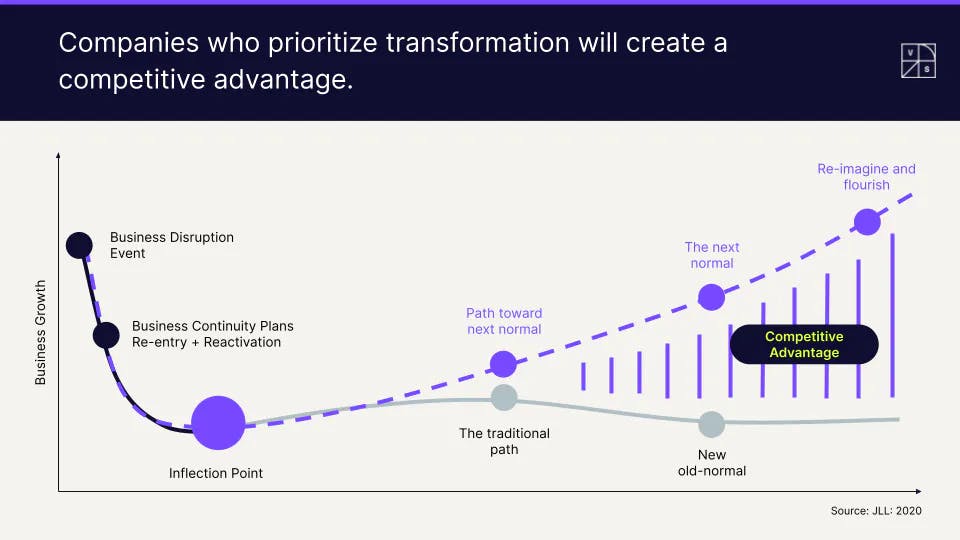Office Space Utilization: How to Increase Efficiency

VergeSense is the industry leader in providing enterprises with a true understanding of their occupancy and how their offices are actually being used.
Corporate real estate strategy is changing at the speed of data. The average office utilization rate in 2019 was on the decline from previous years at 27%.
Corporate spaces were previously measured by access to amenities like game rooms and beer gardens. Now, office value is measured by employee comfort and use of spaces. CRE leaders are looking at spaces and how they can be designed to serve the evolving ways that employees want to use them.
Today, CRE leaders are taking a hard look at their corporate real estate portfolios and are reviewing their office spaces. Square footage needs per employee are shrinking and the expectation around dedicated individual workspaces, workstations and conference rooms have dramatically changed. There is also a new focus on smart office technology to track office usage, and many companies are shifting to a satellite office model as a result of people moving out of cities.
A major part of the push to re-allocate office space and optimize CRE portfolios is improving use of corporate office space and increasing overall office utilization. When companies are spending upwards of $70 per square foot for office space in cities like New York and San Francisco, and require around 200 square feet per employee in the office, they want to ensure that people are using these spaces effectively.
By leveraging a workplace strategy that pairs office space surveys, building and facility management teams, and workplace analytics fueled by smart sensors, companies can increase office utilization and right-size corporate spaces as well.
Why does office space utilization matter?
An office space utilization rate refers to the number of employees in a particular space divided by the capacity of that space. This metric is integral in understanding peak usage times and other variables that affect how spaces are being used. When you are able to understand the space utilization of your office, you can take concrete measures to boost efficiency and ROI by leveraging the feedback loop of workplace decisions, and how these decisions impact office space utilization.
While CRE costs are a huge factor when it comes to companies encouraging employees to take advantage of office space, it’s about more than just that. When office spaces are designed and equipped with the technology employees need, employees are more productive, stay at companies longer, and produce better work. Additionally, employees want flexible work options, and as of 2021, 67% of employees want access to more in-person work and opportunities to collaborate. By addressing these needs, companies will become more competitive and attractive to top talent.
By equipping offices with the right balance of dynamic seating options, bookable workspaces, collaborative spaces, and smart meeting rooms, companies can impact their overall performance and output, while improving the day-to-day lives of their employees.

When Rapid7 opened their modern office in Belfast, they prioritized creating a workplace for people to use to the fullest. Michael Keimig, senior real estate manager at Rapid7 explains the choice for a smart, wellness-centered office design that includes a ‘maker space’ for employees— “We are solidifying our position to attract the best cybersecurity talent. Our focus on providing a safe, comfortable and engaging workspace for our employees is a long-term goal.”
How is office space utilization data collected and calculated?
Office utilization data encompasses all of the ways that people are using (or not using) office spaces, relative to the capacity of these spaces. Office utilization data can be used for office space planning and is often collected as part of a larger workplace strategy or corporate real estate optimization strategy.
The easiest way to collect office space utilization data is by installing IoT sensors in the workplace and analyzing room utilization, desk utilization, floor utilization, or building utilization using a workplace analytics platform. This is done over time to account for seasonal or environmental trends that may impact the day-to-day use of the office.
Another way to collect and calculate office utilization is by conducting office space surveys or workplace design surveys and using the results to guide or supplement occupancy data collected by sensors.
To calculate office utilization, take the capacity for the space and divide it by the use of the space on a given day, at a given hour, or as an average over a period of time. The capacity of office spaces can be calculated using an ideal employee-to-seat ratio, which accounts for employees who are working on a flexible schedule or companies who use a hybrid work model.
By using regular office occupancy reporting, companies can better predict office use and eliminate unpredictability, thus improving overall office space use and reducing employee absenteeism.
How to Design + Implement an Office Space Survey
When designing a workplace strategy, office space surveys can provide qualitative data that can accompany quantitative workplace data, provide areas to explore with further workplace design research, or indicate trends in positive or negative employee experiences that are related to the workplace.
To design an office space survey that evaluates employee engagement at work, ask questions that address the following:
- How well do existing office spaces meet their workplace expectations?
- What could be changed to make the office more comfortable? Safe? Conducive to innovation and productivity? Convenient?
- How do you use individual workspaces? Where are they in the office? How do you use collaborative spaces at work? Why do you use collaborative spaces?
- What do you need to be productive at work?
- Do you have the amenities you need to be successful?
- What motivates you to come into the office?
- What detracts from coming into the office?
Each team, department, building, or floor will have unique trends and feedback that are revealed in office space surveys. Address each area as its own segment and capture location-specific data to provide actionable insights for each team or department. Include questions in your workplace survey about office-related accommodations, habits, preferences, features, expectations, and aesthetics, from both an individual and team perspective.
To deploy office space surveys that encourage participation and meaningful responses, promote the survey where employees can fill them out in the moment while using office spaces. Consider using a QR survey software to deploy office space surveys and posting the QR code in meeting rooms, individual work areas, and collaborative spaces. Workplace design surveys can be sent out via email or SMS as well, and should be run regularly to account for changes over time.
For all workplace surveys, make sure responses are anonymous to promote honesty.
Combining Office Space Survey Data with Workplace Analytics
Companies that have efficiency goals in the workplace need more than office space planning surveys to adequately implement a workplace design strategy. When office surveys are combined with workplace occupancy data, often with the help of a workplace strategy consultant and workplace analytics platform, companies can find opportunities to make changes that improve office use in an exponential way.
Here’s how you can leverage the power of both workplace analytics and employee office space surveys:
- Use workplace surveys to supplement gaps in data collection.
- Conduct a regular workplace analysis using office occupancy reports and workplace design survey data.
- Incorporate office survey data and occupancy reporting into building and facility management strategy.
- Utilize occupancy data to guide workplace solution decisions.
Office Utilization is Improved by Predictable Attendance
In today’s hybrid work model, a workplace model that is employed by 74% of companies returning to the office, employees can work remotely, in the office, or use a combination of both. This creates a challenge for workplace experience teams and leadership teams. How will we accommodate in-person work when we don’t know how many employees will be using the office on a given day?
When this is paired with health and safety concerns, any unknowns surrounding the work environment can be enough of a reason to opt out of using office spaces. Without a clear action plan and return to office framework, employees will feel anxious about returning to the workplace. By leveraging the patterns and data generated by workplace analytics tools, you can create transparency around office attendance and offer employees the autonomy to decide when they would like to come into the office based on how busy the workplace is.
Industry leaders advise companies who are evaluating office spaces to make sure employees feel heard about workplace concerns and allow for flexibility with the return to office, providing transparency into all workplace design decisions. Amy Gallo, a leader in workplace dynamics, also recommends that organizations run experiments and pilot programs, then collect data and adjust accordingly as part of a larger office transformation strategy.
Organizations around the world are committing to creating data-driven workplaces designed for meaningful employee engagement and experience. Take a look at these companies that have undergone inspiring workplace transformations, by simply leveraging workplace analytics tools and taking an increased interest in how their offices are being used.